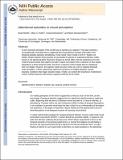Attentional episodes in visual perception
Author(s)
Wyble, Brad; Bowman, Howard; Nieuwenstein, Mark; Potter, Mary C
DownloadPotter_Attentional episodes.pdf (3.364Mb)
OPEN_ACCESS_POLICY
Open Access Policy
Creative Commons Attribution-Noncommercial-Share Alike
Terms of use
Metadata
Show full item recordAbstract
Is one's temporal perception of the world truly as seamless as it appears? This article presents a computationally motivated theory suggesting that visual attention samples information from temporal episodes (episodic simultaneous type/serial token model; Wyble, Bowman, & Nieuwenstein, 2009). Breaks between these episodes are punctuated by periods of suppressed attention, better known as the attentional blink (Raymond, Shapiro, & Arnell, 1992). We test predictions from this model and demonstrate that participants were able to report more letters from a sequence of 4 targets presented in a dense temporal cluster than from a sequence of 4 targets interleaved with nontargets. However, this superior report accuracy comes at a cost in impaired temporal order perception. Further experiments explore the dynamics of multiple episodes and the boundary conditions that trigger episodic breaks. Finally, we contrast the importance of attentional control, limited resources, and memory capacity constructs in the model.
Date issued
2011-08Department
Massachusetts Institute of Technology. Department of Brain and Cognitive SciencesJournal
Journal of Experimental Psychology: General
Publisher
American Psychological Association (APA)
Citation
Wyble, Brad; Potter, Mary C.; Bowman, Howard and Nieuwenstein, Mark. “Attentional Episodes in Visual Perception.” Journal of Experimental Psychology: General 140, 3 (2011): 488–505 © 2011 American Psychological Association (APA)
Version: Author's final manuscript
ISSN
1939-2222
0096-3445